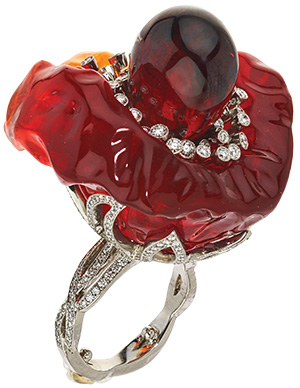|
Colored Gemstone
Color Dance
Fire opals are prized for their vivid orange and play of color.
By Sheryl Jones

|
| Pioneer Gems |
Orange and red fire opals have fascinated people for thousands of years. Much of the stone comes from Mexico, where it is considered the country’s national gemstone. The Mayans and Atzecs had a special reverence for fire opal, using it in their ceremonial rituals. They called it “Quetzalitzlipyolliti,” which means stone of the bird of paradise because the flash of colors is similar to beautiful, colorful birds flying and dancing in the air. During the 1500s, fire opals made their way from Mexico across the Atlantic Ocean along the old trade route to Egypt and then to India, where Mughals adorned themselves with this brilliant stone.
Rediscovered in the 1800s, the stone became known as fire opal. Ashok Sancheti, president of Pioneer Gems, says the name is due to the similarity of the different colors that appear “when one looks into fire; there are sparks of yellow, blue and green colors dancing and moving.”
This dancing is known in the industry as “play of color” and is due to the diffraction of light off the tiny silica spheres within the stone. They must be in a uniform pattern to create the play of color. If not, it is classified as a common, opaque opal. The orange and red color of the stone, which is also known as body color, is due to traces of iron oxide. The fire red and orange body color may attract on its own, but it’s this play of color that is mesmerizing.
Even though scientists have explained what makes play of color and the stone orange and red, the fire opal still stirs the imagination. Sancheti says he “only touches a stone if it is spectacular.” He recalls he was smitten when he bought a beautiful piece of orange, red and yellow rough fire opal in the shape of a flower. He was inspired to create a piece of jewelry that reflects his love of nature and the raw beauty of gemstones. After thinking about the best piece of jewelry to make, he created a ring, shown opposite.
Many buyers may not get an opportunity to have such a large, special one-of-a-kind stone as Sancheti’s creation, but the flashes of color make each fire opal incomparable. Emily Parker, a private client consultant at Gemvara, an online fine jewelry store, says, “I think it is a very unique stone and for someone who loves orange, it is perfect. It’s bright and beautiful and for our customers who like to create pieces that are very unique to their style, fire opal is a great choice.”
When selecting an opal, the International Colored Gemstone Association (ICA) advises that there are three criteria that determine value: play of color, body color and transparency. The more transparency and fire the stone has, the more intense the deep red and orange of its body color. These factors, along with size, and shape, are a part of the selection process. According to Rachel Klayman, senior stone buyer for Gemvara, “Most of our customers prefer larger stones when purchasing fire opal because the color usually attracts attention and becomes the focal point of a piece of jewelry.” Marc Sarosi, owner of Africa Gems, an online fine jewelry store, explains, “Round and oval are best, as the play of fire is most easily seen when you rotate or move the stone around.”
This distinctive stone is also known to many because it is the birthstone for October. Sarosi says he sees “a slight uptick in sales during October.” And as colored gemstones have become popular for engagement rings, so has fire opal. Parker says, “ I have noticed a growth in people shopping for fire opal engagement rings. But fire opal is a soft stone and I always tell customers that it is not going to be their best choice for an everyday ring.” If they do select one, she suggests a setting that protects the stone, such as a bezel.
“I think when you are going with such a bright and vivid stone like fire opal, it’s best to accent it with a diamond or white sapphire,” Parker goes on to say, “that way the fire opal really stands out and the diamonds or white sapphires are there just to enhance the beauty of the fire opal.”
The growth in popularity of the fire opal has affected supply of larger, better-quality material. The most abundant and best-quality source is still Mexico. But Ethiopian opal has become known for very good quality black and fire opals. According to Sarosi, “With the discovery of Ethiopian opals, prices on that material are getting higher, especially on exceptional stones.”
Some dealers have seen the price for spectacular fire opal reach as much as $600 per carat. Sarosi notes, “With opals, even a little more color makes the price go up quite a bit.” He points out that when Ethiopian opals came out around 2003, he was buying “amazing” stones up to 50 carats for $200 to $300 per carat compared to now, where prices range from $400 to $600 per carat for top-end, larger sizes of black and fire opal. However, lower end or commercial quality stones fall into the $15 to $24 per carat price range.
Ephrem Getachew, manager of Dil Commercial Plc., an Ethiopian opal gem exporter, believes fire opals from Ethiopia “will become more popular and valuable because the kaleidoscope of color and the hues of orange and red are unique in each stone and makes them totally different from any other gemstone.”Article from the Rapaport Magazine - September 2015. To subscribe click here.
|
|